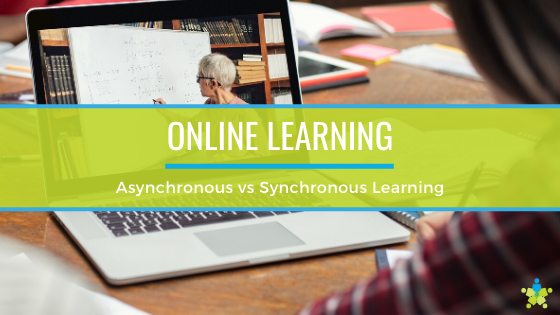What Is Asynchronous vs Synchronous Learning?
Distance education is no longer the future—it is the here and now, and school districts nationwide are quickly establishing an online presence for their students and teachers. In Texas, the Texas Education Agency (TEA) is pushing districts into quickly adopting distance learning and has outlined what schools can do to maintain funding for distance learning students.
A major decision facing every school is whether to offer asynchronous or synchronous coursework. Here’s what the terms mean:
Synchronous
Synchronous learning refers to online courses that are taught live. That means the instructor delivers the lesson to students directly, interacting with those students as if they were in the classroom. Synchronous learning emphasizes the social aspect of schooling, as students can discuss lesson materials with the teacher and with each other.
Asynchronous
Asynchronous learning refers to online courses that are not taught live, but instead recorded and uploaded to a website that students can access. The teacher may be available to help with lessons through some avenue of communication, but asynchronous classes emphasize self-learning. There are upsides to both options, but whether your school prefers synchronous or asynchronous learning, additional technology will be required to deliver it effectively.
What Technology is Needed For Asynchronous and Synchronous Learning?
Whether synchronous or asynchronous, distance learning is only possible with several technologies. Some of them include:
Video and audio capturing
Modern camera and audio technology is compact and easy to handle, so schools have options in capturing video and audio. Once captured, the video can either be streamed live or saved and uploaded to a site.While schools can piece together a custom setup, it is usually easier for educators to work with an all-in-one system for their lesson delivery. Some all-in-one systems, like the VIEWpath, include a camera, microphone and a beamforming array that doubles as an amplifier and receiver. Everything is built into one package so teachers know that all components are working together at the same time.
Video conferencing
Video conferencing is helpful for educators and administrators, as it can drive synchronous learning and ensure admins can work together remotely. Video conferencing systems include popular platforms like Zoom, Microsoft Teams and Google Hangouts. They also include traditional hard codec systems like those offered by Poly (formerly Polycom).
Classroom management tools
Classroom management tools are a must for any teacher engaging in distance learning. Google Classroom is one such tool, but there are many others. With classroom management, teachers can easily give direct, private feedback to students and their parents. Teachers can also securely grade coursework, start and monitor classroom discussions, deliver lessons and deliver quizzes. With their wide-ranging functionality, classroom management technology facilitates asynchronous and synchronous learning.
The Benefits of Asynchronous Learning
So which form of learning is right for your classroom? There isn’t a clear answer because asynchronous and synchronous learning appeal to different kinds of students. That is why some districts are considering a blend for their students.If your district is weighing its options, here’s why asynchronous learning is popular among some students:
Convenience
Many students have trouble comfortably fitting into a traditional schooling schedule. Asynchronous learning is perfect for these students, as they can access lessons at their own pace (within reason). This is a primary reason that adult students are drawn to distance learning.
Self-driven learning
While many students thrive in a traditional classroom setting, where discussions and feedback are standard learning tools, some students prefer learning on their own. For these students, asynchronous learning provides a comfortable, stable environment for optimal learning. This environment also fosters self-confidence as the child achieves goals at their own pace.
The Benefits of Synchronous Learning
The vast majority of students are accustomed to synchronous learning, as it most resembles the traditional classroom experience. There are notable advantages to synchronous lessons, including:
Instant feedback is available
Synchronous learning allows students to ask questions as they emerge during the lesson. Using a classroom management platform, the teacher can provide feedback individually, which makes synchronous learning better than in-person in at least one way. Students that would be too timid to ask questions in the classroom can freely ask them during a live remote learning session.
Additional engagement tools available
Synchronous learning has room for live discussions between the teacher and the students. Further, teachers can use things like instant polls to determine what material needs reinforcement.
Easier to track attendance
It is possible to track attendance with an asynchronous learning approach, but it’s more difficult. With synchronous learning, teachers can take attendance live, so it only has to be done once. With everything to keep track of, this can remove some of the micromanagement that comes with classroom management. Distance learning is here to stay—the question is what form will that distance learning take? For some districts, the convenience of asynchronous learning may be too much to ignore. For others, the classroom-like experience of synchronous learning will win out. In either case, there are several technologies your district will need to establish a proper distance learning program. Your AV integrator can help present, install and configure these technologies and ensure they are available when your students are ready to go online.



